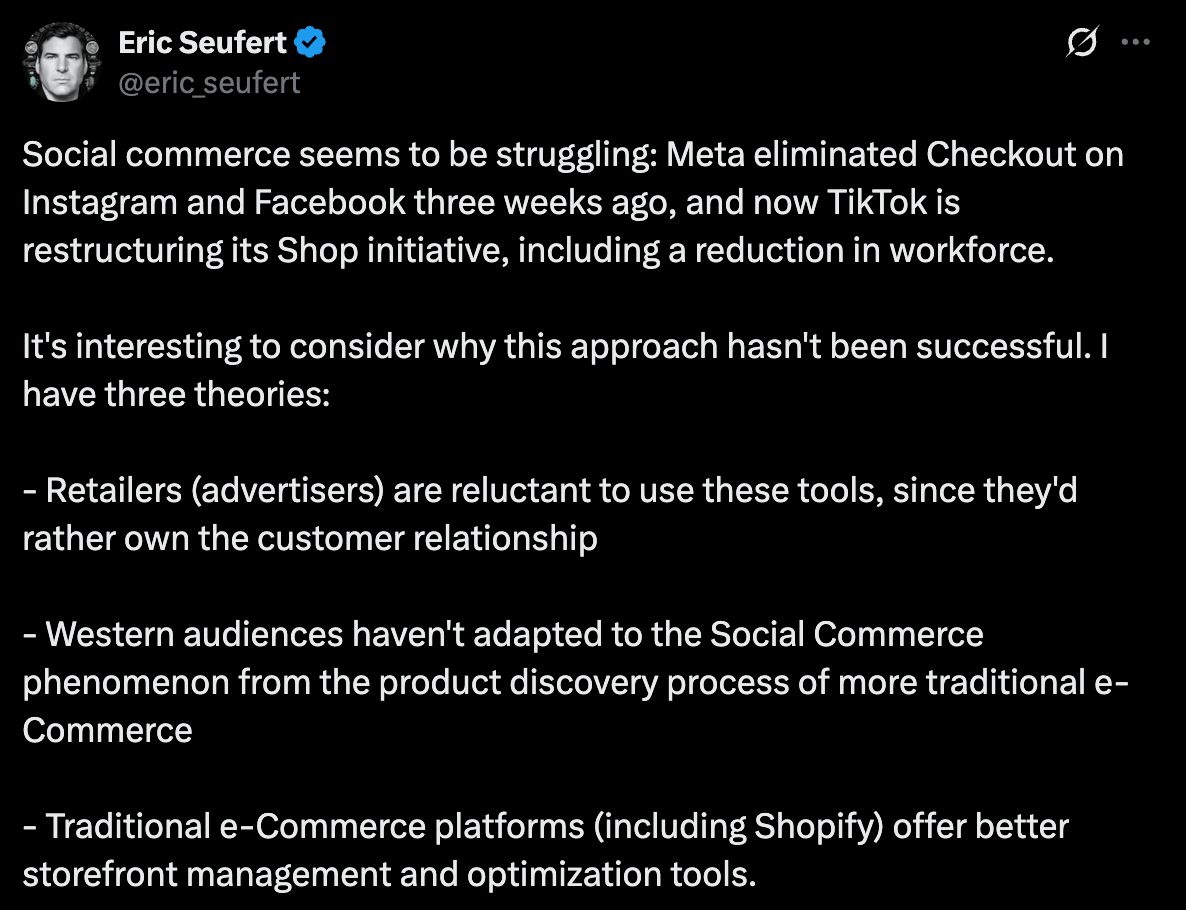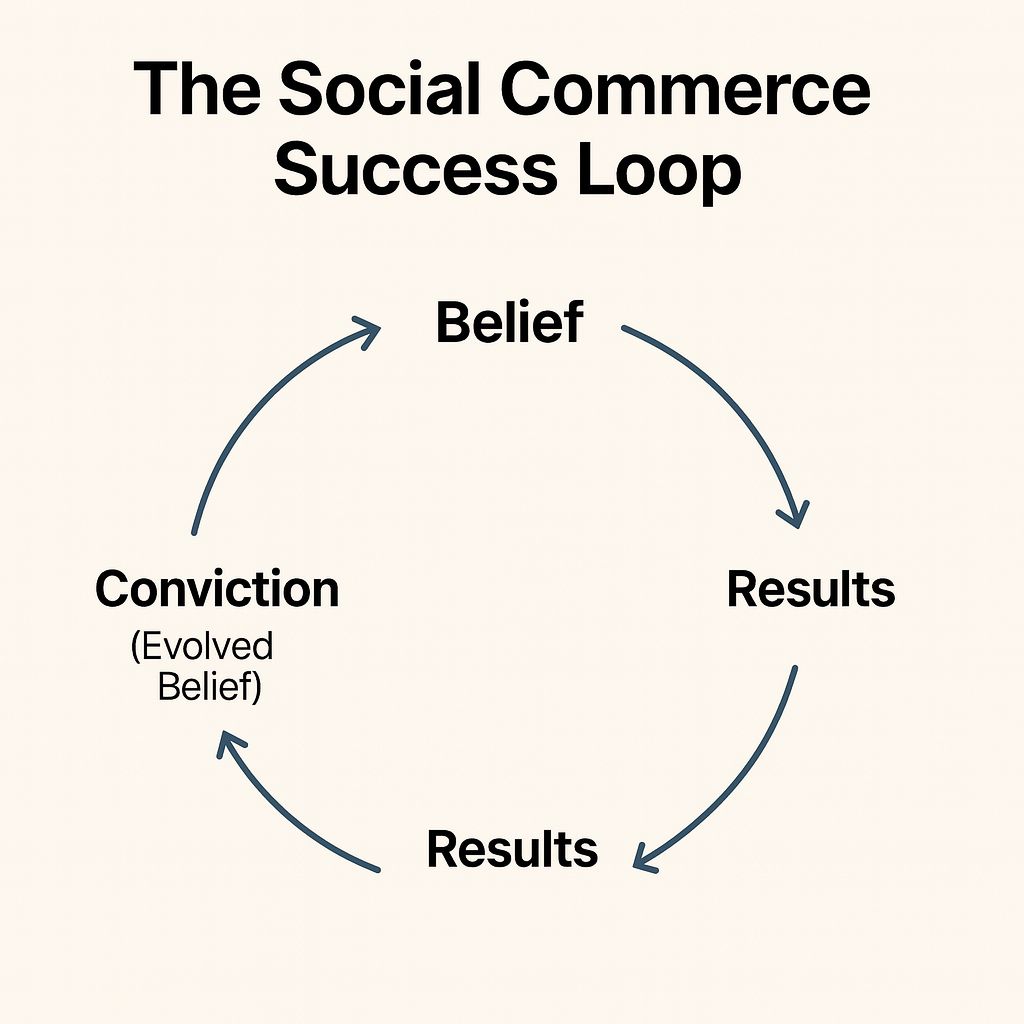- TikTok Shop Playbook
- Posts
- Is Social Commerce Failing in the U.S.?
Is Social Commerce Failing in the U.S.?
In today’s newsletter, I’m responding to this tweet:

There’s some conversation lately about whether social commerce is actually working in the U.S., and it’s a fair question. On the surface, it does look messy — some brands are killing it, while others are burning money without results.
But here’s where I want to offer a counterpoint:
The people who say social commerce isn’t working are usually the ones not truly in the game. If you go talk to the top sellers on TikTok Shop, they’ll tell you something completely different.
Belief → Effort → Results → Belief
Top TikTok Shop sellers are all-in. They’ve hired teams around it. Built their fulfillment and pricing strategy around it. Created products specifically for it. And optimized creators, video formats, and offers to drive consistent results.
They believe in it — and that belief fuels real investment. That investment leads to learning, iteration, and eventual scale. That scale reinforces their belief.
I’ve seen sellers build entire teams — 10 people deep — just to run their TikTok Shop operation.
We’re talking:
Creator outreach
Creator/Community management
Customer service
Fulfillment coordination
Daily performance tracking
That’s not a test. That’s a legit operation.
When you go that deep, success isn’t an accident — it’s inevitable.
Meanwhile, many skeptics treat social commerce like an experiment. They upload a handful of products, reuse old Meta creatives, and hope a few affiliates will do the heavy lifting.
When it doesn’t work right away, they say “See? Told you. TikTok Shop is a scam.”
Social commerce isn’t working for them — but that’s because they never really gave it a chance.
It’s a self-fulfilling prophecy.
Belief creates effort. Effort creates results. Results create belief.
Everything is impossible… until someone makes it possible.

First-Principle Thinking: What is Social Commerce?
Let’s zoom out and ignore the hype for a second.
At its core, social commerce combines two behaviors:
Discovery through native content (short-form, unpolished, creator-led)
Conversion within the same platform (instant checkout, no friction)
It works because it matches how consumers now behave.
We scroll instead of search. We watch instead of read. We want immediacy instead of steps. There’s no website redirect. No retargeting funnel. No middleman between “I want this” and “I bought it.”
The ad is now the product page. The creator is the sales funnel.
And TikTok has turned that behavior into a transaction layer — one that’s fast, addicting, and frictionless.
So if it’s such a natural fit….
What Could Kill It?
If social commerce is so natural — so native to how people behave — why do so many say it’s struggling?
The truth is, most people are pointing to surface-level symptoms, not real root causes.
If we’re using first-principles thinking, here are the real existential risks to TikTok Shop:
Regulatory risk – The biggest and most obvious threat. If U.S. lawmakers ban TikTok, or force a divestiture that derails product development, social commerce momentum could stall.
Loss of trust – If consumers repeatedly get scammed, receive poor-quality products, or have terrible customer support experiences, they’ll stop buying — and creators will stop promoting.
Operational friction – If shipping takes weeks, returns are a nightmare, and the platform experience feels janky, retention will drop and growth will flatten.
Those are the core issues that could derail the platform.
Everything else — “it doesn’t work for our brand,” “consumers aren’t buying from social,” “we haven’t cracked it” — are symptoms of execution, not structural failure.
The Biggest Misunderstanding: TikTok Shop ≠ Meta Shop
This is where a lot of people get confused.
They lump TikTok Shop into the same bucket as Meta Shops or YouTube Shopping — but those are completely different animals.
To understand why, we need to divide eCommerce into two primary arenas:
Marketplace commerce (Amazon, Walmart, Target)
DTC commerce (Shopify sites, brand-owned channels, email/SMS)
In China, marketplace commerce dominates. Nearly 90% of online purchases happen inside platforms like Taobao, JD, or Pinduoduo. DTC is almost non-existent.
In the U.S., the split is more balanced, but marketplaces still hold a majority share.
Amazon alone makes up nearly 40% of U.S. eCommerce sales, and when you add in Walmart, Target, and others, it’s clear that marketplace-driven shopping is the default behavior for many consumers.

Now here’s the thing most people miss:
TikTok Shop is not trying to become Shopify. It’s trying to become Amazon.
TikTok Shop isn’t Meta’s “Shop tab” or a Shopify plugin.
It’s a full-stack marketplace — with its own cart, fulfillment network, review system, recommendation algorithm, and merchant infrastructure.
The twist?
Instead of a static product listing with star ratings and SEO keywords, the storefront is a feed of viral videos.
That’s what makes TikTok Shop so powerful — and so misunderstood.
It’s Amazon + YouTube, blended into one seamless experience.

Why It Feels Like It’s Failing
So, why does the narrative persist that social commerce “isn’t working”?
A few reasons:
Most DTC brands are treating TikTok Shop like another paid channel.
They repurpose DTC ads, expect instant ROI, and judge success on CPMs and ROAS. But TikTok isn’t just an ad platform — it’s a culture engine. It rewards creativity, iteration, and community.There's still friction in the U.S. consumer mindset.
TikTok Shop is new here. Buying directly from a creator you just discovered 15 seconds ago still feels risky to many people. That’ll change with time, trust, and better onboarding.Media coverage loves a contrarian take.
It’s more interesting to say “this whole thing might be a bust” than to admit “this is a new channel with a learning curve.” But just look at the GMV growth. Or talk to top sellers. The money’s moving — it’s just not moving uniformly.
The Winners Are Already Pulling Ahead
We’re at the point in the adoption curve where early believers are compounding their lead.
They’re not asking if social commerce works. They’re asking:
How do we scale with creators without losing quality?
How do we optimize pricing to balance affiliate margin and profitability?
How do we retain buyers and build LTV in a marketplace?
Those are questions the best tiktok shop sellers are focusing on.
Belief comes first.
It drives effort. Effort drives results. Results drive conviction.
That’s how every wave of digital transformation plays out — including this one.